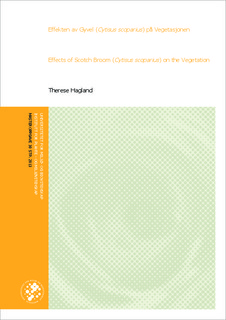| dc.description.abstract | Gyvel (Cytisus scoparius) er en busk som i mange Europeiske land har blitt en problemart. I dag tror man at gyvel kan være en stedegen art og en opprinnelig vill plante i norsk flora. Gyvel finnes i store mengder i kystlyngheiene på Lista, og mange mener at arten har blitt en problemart. En problemart vil kunne ha stor effekt på artssammensetningen og vil kunne utgjøre en trussel for hjemmehørende arter. Kunnskap om gyvel i Norge er mangelfull og få studier har blir gjort på denne arten tidligere i Norge. Formålet med dette masterprosjektet var å undersøke om gyvel hadde effekt på vegetasjonen. Registrering av gyvel ble gjort sommeren 2012 i perioden 19.-26. juni, på Lista i Vest-Agder. Fem forskjellige områder ble valgt ut og totalt 83 busker ble registrert. Under hver registrering ble høyde, omkrets, stammetykkelse og UTM posisjon målt for alle gyvelbusker. Antall blomster på buskene ble anslått og det ble også anslått i prosent hvor mye av hver busk som var døde. Gjennom ruteanalyser av vegetasjonen ble det for de fem områdene undersøkt om det var forskjell i antall arter innenfor og utenfor buskene, og om det var noen forskjeller i antall arter nord og sør for gyvelbuskene. Resultatet viste at det ikke var signifikante forskjeller verken utenfor og innenfor buskene, eller nord og sør for gyvelbuskene. På skrotemark var gjennomsnittet av antall arter og buskhøyden større enn på lynghei. Buskene på lynghei hadde større gjennomsnittlig omkrets enn buskene på skrotemark. Det var ingen signifikant forskjell i stammetykkelse mellom gyvelbusker registrert på lynghei og skrotemark. På lynghei var det signifikant forskjell i antallet arter innenfor og utenfor gyvelbuskene, mens for skrotemark var det ingen forskjell. Denne studien gir ikke tilstrekkelig med bevis for å kunne fastslå at gyvel har effekt på vegetasjonen. Videre registrering og forskning på gyvel vil være nødvendig for å kunne finne ut om gyvel har effekt på andre arter. Resultatene i dette masterprosjektet vil være viktig ved senere studier av arten i Norge. Scotch broom (Cytisus scoparius) is a shrub that in many European countries has become a problem species. It is currently believed that Scotch broom can be a native species and a native wild plant in the Norwegian flora. Scotch broom is found in large quantities in the costal heathlands at Lista, and many believe that this species has become a problem species. A problem species may have a major effect on the surrounding vegetation, and could pose a threat to native species. Knowledge about Cytisus scoparius in Norway is scarce and there have been done very few studies on this particular species in the past. The purpose of this project was to determine whether the Scotch broom had an effect on the vegetation. The registrations were done in the summer 2012, in the period from June 19th to 16th on Lista in Vest-Agder county. Five different areas were selected and a total of 83 shrubs were recorded. During each registration were height, circumference, stem thickness and UTM position measured for all shrubs. The number of flowers on the shrubs and the percentage of the shrubs that were dead were estimated. The differences in vegetation for the five locations were analyzed by path analysis. It was examined whether there was a difference in the number of species within and outside of the shrubs and whether there were any differences in the number of species north and south of the shrubs. The results showed that there was no significant difference in the number of species within and outside the shrubs and neither north and south. The number of species and the shrubs height was greater on wasteland than heathland. The shrubs growing on heathland had larger average circumference than shrubs on wasteland. There were no significant differences in stem thickness between shrubs registered on heathland and wasteland. On the heathland, there were significant differences in number of species within and outside the shrubs, but for wasteland there were no differences. This study does not provide sufficient evidence to establish that the Scotch broom has an effect on the vegetation. Further registrations and research on Cytisus scoparius will be necessary in order to conclude on its effect on other plant species. The results of this project will be important for the future study of the species in Norway. | no_NO |
